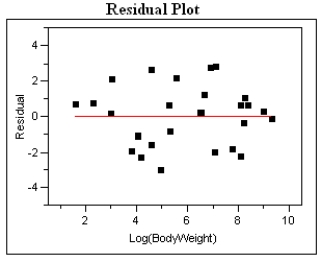Exhibit 4-7
Golden-rumped elephant shrews have long flexible snouts, used to overturn leaf-litter where they find their food: millipedes, insects and spiders. These animals are among the approximately 10% of mammalian species that mate for life. Just why these mammals are monogamous is poorly understood, and one theory is that a monogamous male would have to defend less territory from intrusion by other males. The home range of an animal, i.e. that area over which they typically travel, is a function of diet and energy consumption of the animal. The energy consumption is, in turn, typically a function of the animal's size. In a recent study, investigators reasoned that if monogamy was related in some way to the home territory, this should be detectable by comparing these animals to other insect-eating mammals. Data were gathered on 27 similar species and are presented in the table below.  After fitting a straight line model,
After fitting a straight line model,  , significant curvature was detected in the residual plot, and two transformed models were chosen for further analysis: the power and exponential models. The computer output for these transformed models and the residual plots follow.
, significant curvature was detected in the residual plot, and two transformed models were chosen for further analysis: the power and exponential models. The computer output for these transformed models and the residual plots follow.
Residual Plot and Statistical Analysis - exponential model 
 Log Home Range vs. Weight
Log Home Range vs. Weight
Log(H) = 0.250 + 0.000231 W  Residual Plot and Statistical Analysis - Power model
Residual Plot and Statistical Analysis - Power model 
 Log Home Range vs. Log Weight
Log Home Range vs. Log Weight
Log(H) = −1.601 + 0.893Log(W) 
-Refer to Exhibit 4-7. These shrews typically weigh 550g and their home range is about 2.9 hectares. Using your preferred model from part (c), locate the Golden-rumped elephant shrew on the appropriate residual plot by marking with a small "x." Does your placement of this point suggest the monogamy of these shrews sets them apart from similar species? In a few sentences, explain why or why not.
Definitions:
Reverse Fault
A fault in which the hanging wall moves up relative to the footwall.
Joint
A fracture in a rock where the rock has been pulled apart slightly without significant displacement parallel to the fracture.
Anticlines
Upward folds or arches of rock layers, often associated with oil and natural gas deposits.
Synclines
Geological folds that dip towards each other from opposite sides, often forming a trough-like structure.
Q19: Suppose a survey was conducted among women
Q23: The general form of a probabilistic model
Q27: The standard error of <img src="https://d2lvgg3v3hfg70.cloudfront.net/TB7677/.jpg" alt="The
Q28: In competitive sports, video recorders have been
Q28: An understanding of bird's choices of habitat
Q35: A target market is a specific group
Q38: An Australian snake, the diamond python, is
Q38: Psychologists have noted that people tend make
Q112: Target markets are people who buy the
Q179: For an annuity due, it is assumed